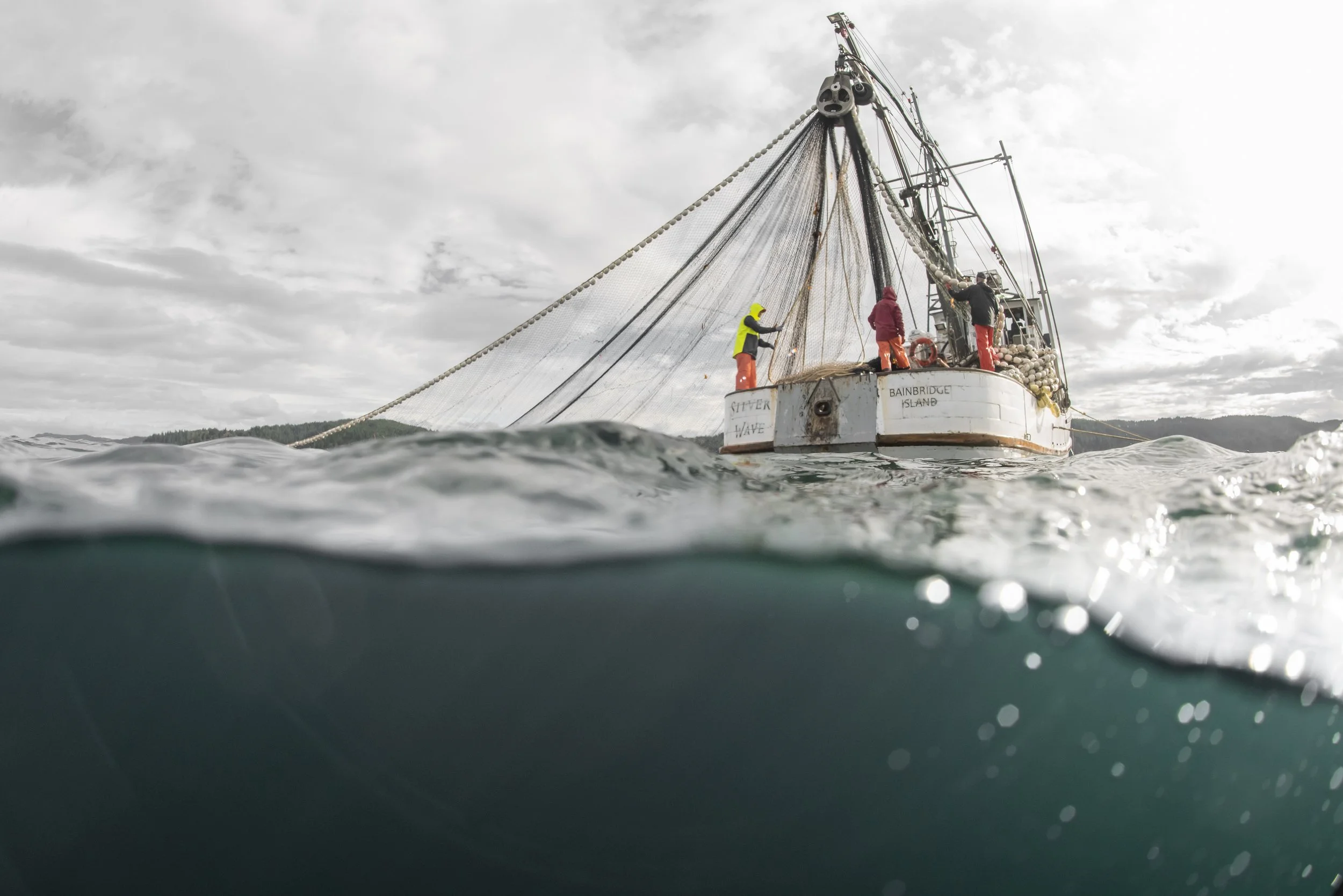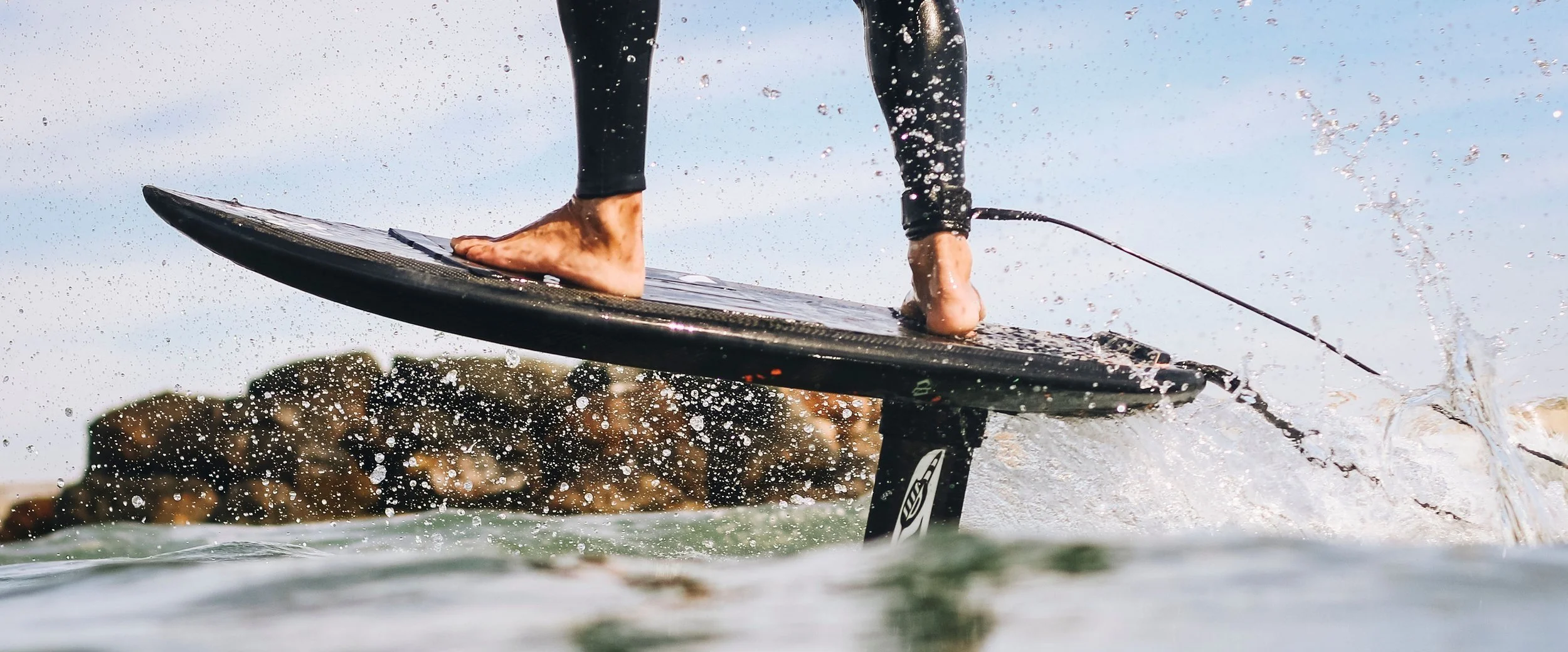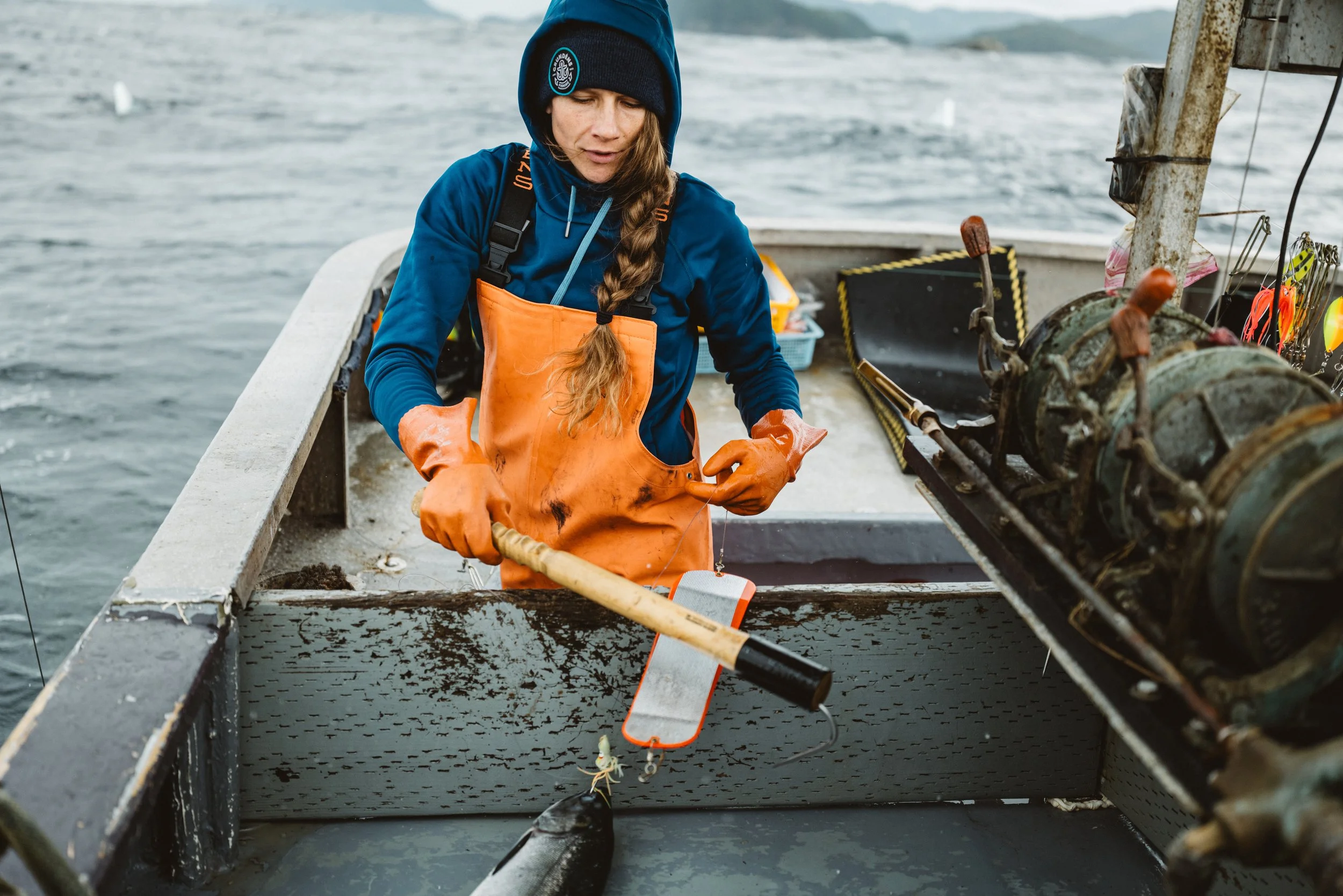riding the wave
Local trailblazers making gear for epic outdoor experiences
Words by Alorie Gilbert
Photo: Grundéns
FROM FOUL WEATHER GEAR FOR FISHING AND CAMPING TO SOUPED-UP SURFBOARDS AND HANDCRAFTED FISHING RODS, THE WEST SOUND IS HOME TO NUMEROUS INNOVATORS AND TRAILBLAZERS IN THE SPORTING GOODS INDUSTRY. WE VISITED FOUR OF THEM, FROM BAINBRIDGE ISLAND TO POULSBO, TO LEARN WHAT INSPIRES THEM AND HOW THEY PUSH THE ENVELOPE ON SUSTAINABLE BUSINESS PRACTICES. IT’S NO ACCIDENT THE INDUSTRY THRIVES IN OUR REGION, WHERE INNOVATION AND INDUSTRY INTERSECT WITH OUR LOVE FOR THE OUTDOORS AND DESIRE TO PROTECT NATURE.
CEDRUS
HYDROFOIL MASTS
Foil surfing, or “foiling,” was pioneered in the 1990s by Hawaiian surfers looking for a new way to ride waves. By swapping a surfboard’s fin with a hydrofoil that lifts the board entirely off the water and reduces drag, surfers increase speed and maneuverability in a wide variety of conditions—all while appearing to defy gravity. Foiling has carried over into other board sports, including kitesurfing, windsurfing, wakeboarding and e-foiling (no wind, swell or boat required).
Kyle Lobisser got hooked on foiling 10 years ago as an avid kitesurfer in the San Francisco Bay Area. A product design engineer for Apple (and a Boeing structural analysis engineer before that), Lobisser was dismayed by the designs of the foiling systems available at the time. He had a hunch he could do better and built a carbon fiber mast for himself in 2016, applying his aircraft engineering know-how to the task. “The foil is a wing in the water,” he notes. “You’re flying on the water instead of air, but it’s essentially the same principle.”
After raising $30,000 in startup funds and a move back to Bainbridge Island (where he grew up), Lobisser launched Cedrus and delivered hydrofoil masts to his first customers in 2018. The business remained a side gig until Covid hit and business “exploded” amid a spike in outdoor recreation and a shortage of sporting goods from overseas. Lobisser quit his day job in 2022 and now assembles and finishes hundreds of masts each year in his Miller Road workshop on Bainbridge Island. Each one is made to order from carbon fiber components supplied by a Port Angeles outfit that repurposes castoff materials from none other than Boeing. Lichen Precision in Kingston supplies all machined aluminum components.
Upcycling is part of the Cedrus ethos of responsible manufacturing. So is Lobisser’s commitment to minimizing waste and consumption by making high-quality, long-lasting, modular products in small batches. A longer product development cycle (3-5 years), recycled packaging and a short supply chain also mean less emissions and environmental impact. It’s an example he hopes the sporting goods industry will follow. / foilcedrus.com
Photos: Finn Kirkpatrick
SAGE FLY FISHING
FLY RODS AND GEAR
Sage Fly Fishing has made fly fishing rods on Bainbridge Island for over four decades, building a worldwide reputation for innovative design and top-notch customer service. The Sage brand is synonymous with hand-crafted quality made in the USA . At its 30,000-square-foot manufacturing plant on Day Road, Sage produces as many as 65,000 rods annually and employs 150 people, making it the largest producer of premium fly rods in the country and second largest employer on the island after the Bainbridge Island School District. “If it has a Sage logo on it, it was made here on Bainbridge Island,” says Director of Marketing David Lantz.
Sage was an early pioneer of high-performance graphite rods, which are stronger, lighter and more responsive than those constructed of fiberglass. Product engineers work continuously to stay at the forefront of new materials, sourcing innovative composites from the same companies that supply Boeing. Proximity to the aerospace industry shortens the supply chain and “elevates the material possibilities,” notes Steve Greist, a Sage materials engineer who’s been with the company for 35 years. (Another iconic local brand linked to the company is K2; its former exec and ski industry scion Bruce Kirschner helped launch Sage with its founder, the late Don Green.)
The company, now operating as Far Bank Enterprises, has broadened its business portfolio and product line over the years, purchasing rod and reel maker Redington in 2003 and later RIO, which produces flies and fly lines. Most recently, Far Bank acquired destination travel company Flywater Travel “to create a holistic, elevated fly fishing experience from rod to location,” Lantz says.
Far Bank sees itself as a steward of both the sport and the natural environment, advocating for the protection of fish and their habitats (catch-and-release is the norm in fly fishing). It donates to dozens of conservation organizations and initiatives from Alaska to Florida, including Wild Salmon Center and Bristol Bay Forever. Far Bank products reflect these values too, through thoughtful design meant to last a lifetime and connect people to nature. “Fly fishing takes you to beautiful places,” says Greist, reflecting on the sport’s allure. “You’re enjoying nature and have your eyes open to a lot of things.” / farbank.com
Photo: Sage Fly Fishing
IGNIK
OUTDOOR HEATING PRODUCTS
Attempting to sail to the Arctic from Puget Sound in 2018, Bainbridge Island-based entrepreneur Graeme Esarey and his family were alarmed by the amount of trash they saw littering the landscape in remote Alaskan fishing villages and along the Inside Passage. The primary culprit were those ubiquitous, single-use propane canisters used for outdoor heating and cooking. Turns out more than 40 million of those little green buggers end up in landfills and the environment every year. During more than a year at sea, the family was also disappointed by hand and foot warmers they hoped would fend off the cold but weren’t quite up to the task.
These experiences inspired Esarey to launch Ignik, a business devoted to keeping people warm on outdoor adventures while reducing waste. Tapping his network and know-how from 10 years in the camping gear industry, Esarey introduced Ignik’s first product in 2019: the refillable Gas Growler, designed as a more sustainable alternative to disposable propane canisters for fueling camp stoves and portable heaters. Esarey has since sold over 75,000 growlers, now available in three sizes, keeping an estimated 700,000 (and counting) single-use bottles out of the trash. Major retailers, including REI, Bass Pro Shop and L.L. Bean, stock the products, which are ideal for car and rooftop camping, RVing, boating and tailgating.
Esarey has expanded the Ignik product line to include compact, propane fire pits and battery-powered electric blankets and seat pads—the envy of any glamper, to be sure. In another effort to reduce waste, the company also makes biodegradable hand and foot warmers that can be resealed in their packaging and used up to three days later.
Ignik manufactures products overseas and assembles them in Puyallup, Wash. Esarey leads an 11-person team of virtual employees from Bainbridge, living on his boat in Eagle Harbor. A lifelong sailor, he’s headed back to the Northwest Passage this summer for another attempt at sailing to the Arctic, a goal that eluded him six years ago. This time, at least, he’ll no doubt be properly outfitted for colder climes. / ignik.com
Photos: Ignik
GRUNDÉNS
FISHING APPAREL
Poulsbo-based Grundéns has been outfitting commercial fishers for over a century. The company’s iconic orange work bibs, introduced in 1954, have protected generations of fishers in the harshest seas and are ubiquitous among Alaskan fishing crews. “When you’re watching Deadliest Catch and you see the orange rain slicks, that’s us,” quips Grundéns Creative Director Frederick Trampe.
For a company with such an eye-catching product, Grundéns Poulsbo headquarters are curiously low-key—tucked away in an inconspicuous office park off Highway 305. The company, founded in Sweden in 1926, has operated here since the early 90s. That’s when commercial fisherman Mike Jackson became the exclusive Grundéns dealer for North America and cracked the Alaskan market. Jackson, whose son Matt remains a board member, lived in Poulsbo. The town’s proximity to commercial fishing fleets in Ballard and Bellingham served the company well and it eventually became home to Grundéns HQ.
The headquarters are now home to 20 or so Grundéns employees. Among them are new CEO and Swedish native Nicolas Cederstrom Warchalowski, who took charge in September, and teams responsible for product development, sales, customer service, finance, marketing, human resources and IT. The company also maintains operations in Europe, including a factory in Portugal, and all manufacturing happens overseas.
Recognizing commercial fishing apparel as a fairly static market, Grundéns launched into new markets in recent years, tripling its sales. In 2015, it scored a Gore-Tex license and introduced lighter-weight sportfishing apparel, followed by a full line of footwear, including boots, deck shoes and sandals. Last year, it unveiled its first fly fishing waders. The products are available at more than 1,200 stores in North America, including local retailers West Marine, Sportsman’s Warehouse, Whistle Workwear and Bay Hay & Feed.
With its future tied to the health of marine ecosystems, Grundéns supports several conservation initiatives and measures. They include Net Your Problem, a Seattle organization that recycles used fishing nets, and Tampa-based Inversa, which harvests non-native lionfish (a threat to coral reefs) for use in leather goods. Grundéns also uses Econyl, a nylon made from recycled plastic, and prides itself on heirloom-quality garments that are indispensable tools of the trade. “People have grown up around our products,” Trampe says. “It’s been ingrained as a generational thing. You hand down your Grundéns.”/ grundens.com
Photos: Grundéns
Bainbrige wing nuts
ISLANDERS CHASE WIND, WAVES & THRILLS WITH NEW WATER SPORT
Most of us cozy up indoors when the wind is raging, stirring the sea into an angry froth. But a growing group of islanders has learned to literally foil such gale-force weather with a mesmerizing combination of surfing, hydrodynamics and wind power. Wing foiling is the art of riding a board with a slender, descending mast attached to a foil wing that lifts the rider more than a foot above the water, propelled by waves and wind.
And not just any wind—the sport requires a steady blow of 15 knots or greater. “Anything less than that, you can still do it, but it’s work,” said Drew Reynolds, part of a tribe of local enthusiasts.
“You see white water and ripping waves out there and these guys are zipping around like it’s nothing,” said Sam Teplitsky, who lives on the shore west of Battle Point Park. “It looks insane.”
Apparently, first responders agree. “I was getting blown downwind, and here comes the fire boat,” recalled Kurt Waeschle, a Poulsbo resident who grew up surfing in Southern California. “I said, ‘Hey guys, I’m OK!’ And they’re like, ‘Are you sure?’” He laughed and shook his head. “I told them, ‘I’m fine. I want to be here!’”
Wing foiling is a dynamic variation of windsurfing, which uses a sail anchored to a board, and kitesurfing. “Wing foiling is more forgiving,” Reynolds explained. “The wing is easier to control than a kite, and the foil board is more efficient and faster than a traditional windsurfing board.”
Over beers at Bainbridge Brewing, Reynolds and his wing-foiling posse shared a visceral sense of thrill and excitement. Most started out kiteboarding, which is a more dangerous pursuit. The group told stories of getting dragged across parking lots, unexpectedly launching 20 feet in the air and dodging power lines—all while kiteboarding.
Wing foiling, on the other hand, offers an exhilarating blend of skill and serenity. Riders have the sensation of gliding above the water’s surface, pushed by waves and pulled by wind, and develop the ability to carve graceful arcs through the water, despite hell-bent weather. “Once you’re up and going,” Reynolds said, “it’s like skiing the ultimate powder day—like bottomless powder. It’s magical and ridiculous. Once you get the mechanics down, it feels like you become the wind.”
The group reported that mastering the basics requires several weeks of continuous practice, which can be challenging when heavy winds are relatively rare. And a basic wing foiling rig costs a couple grand, which adds a financial barrier to the nascent sport. But it’s clear that for this tight-knit community, wing foiling has become more than just a sport. “We’ve all got different backgrounds,” Reynolds explained, “but we share a passion for the water. There’s now a dozen of us, always checking the wind and looking to get back out there. We’re like a bunch of kids eagerly awaiting the next storm. And that is an awesome stoke.” / Rob Dalton









